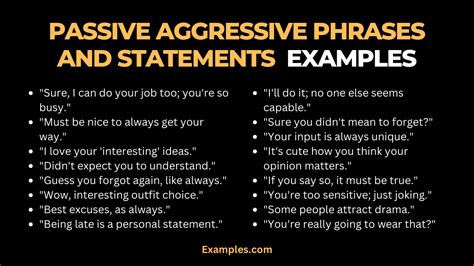
Thirteen seemingly innocuous phrases can be red flags indicating passive-aggressive behavior, potentially undermining communication and relationships, according to experts. These phrases, often veiled in politeness or concern, mask underlying resentment or frustration, creating confusion and conflict. Recognizing these phrases is crucial for fostering healthier interactions.
The seemingly simple word “fine,” often delivered with a specific tone or body language, can be a prime example of passive-aggression, signaling displeasure while outwardly appearing agreeable. According to experts, other phrases such as, “I was only joking,” “Whatever,” “You always/You never,” “I’m not angry,” “If that’s what you want,” “I’m doing this for your own good,” “Don’t worry about it,” “You should,” “Okay,” “As you wish,” “Did I ask you?” and “I’m sorry you feel that way” can also be indicators of underlying passive aggression. These phrases allow individuals to express negative feelings indirectly, avoiding direct confrontation while still communicating their discontent. Recognizing these verbal cues can help individuals navigate complex relationships and address conflict constructively. Understanding the dynamics of passive-aggressive communication is essential for promoting open dialogue and fostering genuine connections in personal and professional settings.
Passive-aggressive behavior, a pattern of indirectly expressing negative feelings instead of openly addressing them, can manifest in various ways, often leaving the recipient feeling confused, frustrated, or manipulated. While some individuals may exhibit occasional passive-aggressive tendencies, consistent use of such behavior can indicate a deeper issue affecting communication and relationships. The phrases listed above are not definitive proof of passive-aggression in every instance; rather, they serve as potential indicators when considered within the context of tone, body language, and the overall relationship dynamic.
Decoding the 13 Phrases
The ability to recognize passive-aggressive phrases is a valuable skill for improving communication and resolving conflicts effectively. Each phrase carries its own subtle nuances and potential implications.
-
“Fine”: This seemingly harmless word can be loaded with unspoken resentment. When delivered with a sigh, eye roll, or terse tone, “fine” often translates to “I’m not okay, but I don’t want to talk about it directly.” This avoidance of direct communication can leave the other person guessing about the true source of the problem. “Fine,” in this context, becomes a dismissive brush-off, shutting down further dialogue and fostering an environment of uncertainty. The true meaning is heavily reliant on context and non-verbal cues. It implies suppressed anger or frustration, making it difficult to address the underlying issue directly. This can create tension and prevent genuine resolution.
-
“I was only joking”: This phrase is frequently used to dismiss or downplay hurtful remarks. When someone delivers a cutting or offensive statement and then uses “I was only joking” as a defense, it minimizes the impact of their words and avoids accountability. The intention is often to deflect criticism and avoid admitting wrongdoing. The phrase implies that the other person is overly sensitive or lacks a sense of humor, shifting the blame and invalidating their feelings. The use of this phrase can be particularly damaging in relationships, as it undermines trust and encourages the speaker to continue making hurtful comments without consequence. It hinders honest communication and prevents genuine apologies.
-
“Whatever”: This dismissive term often signals disinterest or resignation. It effectively shuts down the conversation and communicates a lack of engagement. “Whatever” can be particularly frustrating for the person on the receiving end, as it implies that their opinions or concerns are not valued. It can also be used to avoid taking responsibility or making a decision. In professional settings, “whatever” can undermine teamwork and create a negative work environment. In personal relationships, it can lead to feelings of isolation and resentment.
-
“You always/You never”: These accusatory phrases are generalizations that rarely reflect reality. Using “You always” or “You never” creates a sense of blame and can make the other person feel attacked. Such statements are often exaggerations that ignore specific instances where the opposite may be true. These phrases are detrimental to communication because they promote defensiveness and prevent constructive dialogue. They create a polarized environment where individuals are more likely to focus on proving each other wrong than on finding solutions.
-
“I’m not angry”: This denial of anger is often a clear indication that someone is, in fact, angry. The discrepancy between words and non-verbal cues, such as a tense posture or raised voice, can be confusing and unsettling. Saying “I’m not angry” while exhibiting clear signs of anger undermines trust and prevents the other person from addressing the actual issue. It forces the other person to navigate a situation where the acknowledged feelings do not match the displayed behavior, which can be highly frustrating.
-
“If that’s what you want”: This phrase implies reluctant agreement, often masking underlying disapproval. It suggests that the speaker is conceding but not genuinely supporting the other person’s decision. “If that’s what you want” can create a sense of guilt or obligation for the person receiving the message, making them feel as though they are imposing on the speaker. It undermines the sense of collaboration and support in a relationship. The lack of genuine enthusiasm can create resentment and tension over time.
-
“I’m doing this for your own good”: This phrase is often used to justify controlling or manipulative behavior. It implies that the speaker knows what’s best for the other person, even if that person disagrees. “I’m doing this for your own good” can be particularly harmful because it undermines the other person’s autonomy and ability to make their own decisions. It can also be used to excuse intrusive or unwanted actions. This phrase often creates a power imbalance in the relationship, leading to feelings of resentment and distrust.
-
“Don’t worry about it”: While seemingly reassuring, this phrase can be dismissive and invalidating. It often implies that the speaker is unwilling to discuss the issue further or that the other person’s concerns are insignificant. “Don’t worry about it” can prevent the other person from expressing their feelings or seeking support. It can also create a sense of isolation and lead to unresolved issues. The underlying message can be interpreted as, “Your feelings aren’t important enough for me to address.”
-
“You should”: This phrase can be perceived as condescending and controlling. It implies that the speaker knows better than the other person and is offering unsolicited advice or criticism. “You should” statements can undermine the other person’s confidence and make them feel inadequate. This phrase is particularly detrimental in situations where the other person is already feeling vulnerable or uncertain. It can create a sense of judgment and prevent open communication.
-
“Okay”: Similar to “fine,” the tone and context surrounding the word “okay” are crucial. A simple “okay” delivered in a clipped or flat tone can communicate dissatisfaction or passive resistance. It can signal a lack of engagement and a reluctance to fully agree or participate. This use of “okay” often serves as a subtle way of expressing disapproval without directly confronting the issue. It can be particularly frustrating when used in response to a request or suggestion, as it leaves the other person uncertain about the speaker’s true feelings.
-
“As you wish”: This phrase can be sarcastic and resentful, implying that the speaker is reluctantly complying with a request they disagree with. It suggests that the speaker feels forced into doing something against their will. “As you wish” is often used to communicate passive aggression and resentment. It can create a sense of unease and distrust in the relationship, as the other person may suspect that the speaker is not genuinely supportive.
-
“Did I ask you?”: This confrontational phrase is a direct way of shutting down unwanted advice or criticism. It’s a dismissive response that indicates the speaker does not value the other person’s opinion. “Did I ask you?” is often used to assert dominance and control the conversation. It can be hurtful and disrespectful, damaging the relationship and preventing future communication. The phrase shuts down any potential for collaboration or constructive feedback.
-
“I’m sorry you feel that way”: This phrase is often considered a non-apology, as it expresses sympathy without taking responsibility for the speaker’s actions. It shifts the blame onto the other person for their emotional response. “I’m sorry you feel that way” is often used to avoid admitting wrongdoing or offering a genuine apology. It can be frustrating for the person on the receiving end, as it minimizes their feelings and avoids addressing the root cause of the issue. It’s considered invalidating and dismissive.
Why People Use Passive-Aggressive Phrases
Understanding the motivations behind passive-aggressive behavior can provide insight into the underlying causes and potential solutions. Individuals may resort to passive-aggression for a variety of reasons, including:
-
Fear of Confrontation: Some individuals avoid direct conflict due to anxiety, fear of rejection, or a lack of confidence in their ability to handle difficult conversations. Passive-aggression provides a way to express negative feelings without directly facing the potential consequences of confrontation.
-
Lack of Communication Skills: Individuals who haven’t developed effective communication skills may struggle to express their needs and feelings in a clear and assertive manner. They may resort to passive-aggression as a substitute for open and honest communication.
-
Power Imbalance: In situations where there is a significant power imbalance, such as in a workplace or family dynamic, individuals may use passive-aggression to exert control or resist authority without directly challenging the dominant party.
-
Learned Behavior: Passive-aggressive behavior can be learned from childhood experiences, particularly in families where direct expression of emotions was discouraged or punished. Individuals may adopt these patterns as a coping mechanism for dealing with difficult situations.
-
Emotional Regulation Difficulties: Some individuals struggle to regulate their emotions effectively. They may use passive-aggression as a way to manage or suppress negative feelings without directly addressing the underlying issues.
The Impact of Passive-Aggression
The consequences of passive-aggressive behavior can be far-reaching, affecting both personal and professional relationships. Some of the negative impacts include:
-
Damaged Relationships: Passive-aggression erodes trust and creates a climate of resentment and frustration. It can lead to misunderstandings, conflicts, and ultimately, the breakdown of relationships.
-
Reduced Productivity: In the workplace, passive-aggression can undermine teamwork, reduce productivity, and create a toxic work environment. It can lead to decreased morale and increased employee turnover.
-
Increased Stress: Dealing with passive-aggressive behavior can be incredibly stressful for the person on the receiving end. It can lead to feelings of anxiety, confusion, and helplessness.
-
Mental Health Issues: Chronic exposure to passive-aggression can contribute to mental health issues such as depression, anxiety, and low self-esteem.
-
Communication Breakdown: Passive-aggression hinders effective communication and prevents the resolution of conflicts. It creates a cycle of negativity that can be difficult to break.
Addressing Passive-Aggressive Behavior
While recognizing passive-aggressive phrases is the first step, addressing the behavior requires a more proactive approach. Here are some strategies for dealing with passive-aggressive communication:
-
Identify the Behavior: Clearly identify the specific passive-aggressive behavior you are observing. This helps to avoid generalizations and focus on concrete examples.
-
Call it Out Directly: In a calm and non-confrontational manner, address the behavior directly. Use “I” statements to express how the behavior makes you feel. For example, “I feel confused when you say ‘fine’ but your body language suggests otherwise.”
-
Set Boundaries: Establish clear boundaries and expectations for communication. Let the other person know that you expect them to express their feelings openly and honestly.
-
Encourage Direct Communication: Encourage the other person to express their needs and feelings directly. Offer to listen without judgment and create a safe space for open communication.
-
Focus on the Underlying Issue: Try to understand the underlying reasons behind the passive-aggressive behavior. Are they afraid of confrontation? Do they lack communication skills? Addressing the root cause can be more effective than simply addressing the symptoms.
-
Seek Professional Help: In some cases, professional counseling or therapy may be necessary to address underlying issues and develop healthier communication patterns.
-
Manage Your Own Reactions: It’s important to manage your own reactions to passive-aggressive behavior. Avoid getting drawn into arguments or engaging in retaliatory behavior.
-
Don’t Take it Personally: Recognize that passive-aggressive behavior is often a reflection of the other person’s internal struggles, rather than a personal attack.
The Importance of Assertive Communication
The antidote to passive-aggressive communication is assertive communication. Assertive communication involves expressing your needs and feelings in a clear, direct, and respectful manner. It involves standing up for your rights without violating the rights of others. Key elements of assertive communication include:
-
Using “I” Statements: Expressing your feelings and needs using “I” statements, such as “I feel frustrated when…” or “I need…”
-
Being Direct and Specific: Clearly stating your needs and expectations without being vague or ambiguous.
-
Active Listening: Paying attention to the other person’s perspective and acknowledging their feelings.
-
Respecting Boundaries: Respecting the other person’s boundaries and avoiding aggressive or manipulative tactics.
-
Maintaining Eye Contact: Maintaining eye contact to convey sincerity and confidence.
-
Using a Calm and Confident Tone: Speaking in a calm and confident tone, even when discussing difficult topics.
By practicing assertive communication, individuals can build stronger relationships, resolve conflicts effectively, and create a more positive and supportive environment.
Real-Life Examples
To illustrate the impact of these phrases, consider the following scenarios:
-
Scenario 1: The Overworked Colleague A colleague consistently agrees to take on extra tasks, but then complains about being overworked and makes comments like, “Fine, I’ll do it, but I have no idea how I’ll manage.” This passive-aggressive behavior creates resentment within the team and undermines collaboration.
-
Scenario 2: The Critical Parent A parent frequently offers unsolicited advice and criticizes their adult child’s choices, saying, “I’m just doing this for your own good.” This undermines the child’s autonomy and creates a strained relationship.
-
Scenario 3: The Dismissive Partner One partner expresses their concerns about a financial issue, but the other responds with, “Don’t worry about it.” This dismisses the partner’s feelings and prevents them from addressing the issue together.
These examples demonstrate how seemingly harmless phrases can have a significant impact on relationships and communication.
Conclusion
Recognizing passive-aggressive phrases is a crucial first step in fostering healthier communication and resolving conflicts effectively. By understanding the underlying motivations behind these phrases and practicing assertive communication, individuals can build stronger relationships, create a more positive environment, and improve their overall well-being. The key lies in promoting open and honest dialogue, respecting boundaries, and addressing underlying issues directly. This requires a conscious effort to break old patterns and adopt new ways of communicating. The result is not only improved relationships, but also increased self-esteem and a greater sense of control over one’s own life. Ultimately, fostering a culture of direct and respectful communication benefits everyone involved.
Frequently Asked Questions (FAQ)
-
Are these 13 phrases always signs of passive-aggression?
No, not necessarily. The context, tone, and body language accompanying these phrases are crucial indicators. A phrase like “fine” can be perfectly acceptable in a neutral conversation, but when delivered with a sigh or eye roll, it can signal passive-aggression. The key is to consider the overall communication dynamic and look for patterns of indirect expression of negative feelings. The intent and the manner in which the phrase is delivered are crucial in determining whether it’s passive-aggressive. A single instance of using one of these phrases does not automatically label someone as passive-aggressive.
-
What’s the best way to respond when someone uses a passive-aggressive phrase?
The best approach is to address the behavior directly and calmly. Use “I” statements to express how the phrase makes you feel. For example, you could say, “I feel confused when you say ‘fine’ but your body language suggests otherwise. Can we talk about what’s really going on?” Setting boundaries and encouraging open communication are also important. Avoid reacting defensively or engaging in retaliatory behavior, as this can escalate the situation. Focus on the underlying issue and try to understand the other person’s perspective.
-
Is passive-aggressive behavior intentional?
It can be both intentional and unintentional. Some individuals are consciously aware of their passive-aggressive tactics, while others may be engaging in these behaviors unconsciously, often as a result of learned patterns or emotional regulation difficulties. Regardless of the intent, the impact of passive-aggressive behavior is often the same: it damages relationships and hinders effective communication. Understanding the root cause of the behavior is crucial for addressing it effectively.
-
Can passive-aggressive behavior be changed?
Yes, with conscious effort and a willingness to learn new communication skills, passive-aggressive behavior can be changed. This often involves identifying the underlying reasons for the behavior, such as fear of confrontation or lack of communication skills, and developing healthier coping mechanisms. Therapy or counseling can be helpful in this process. It also requires a commitment to practicing assertive communication and being more open and honest about one’s feelings and needs.
-
How can I avoid being passive-aggressive myself?
The first step is to become aware of your own communication patterns. Pay attention to the phrases you use and the tone and body language that accompany them. Practice expressing your needs and feelings directly and assertively, using “I” statements. Learn to manage your emotions effectively and address conflicts constructively. If you struggle to communicate assertively, consider seeking guidance from a therapist or communication coach. Self-reflection and a genuine desire to improve your communication skills are essential for breaking the cycle of passive-aggression.









